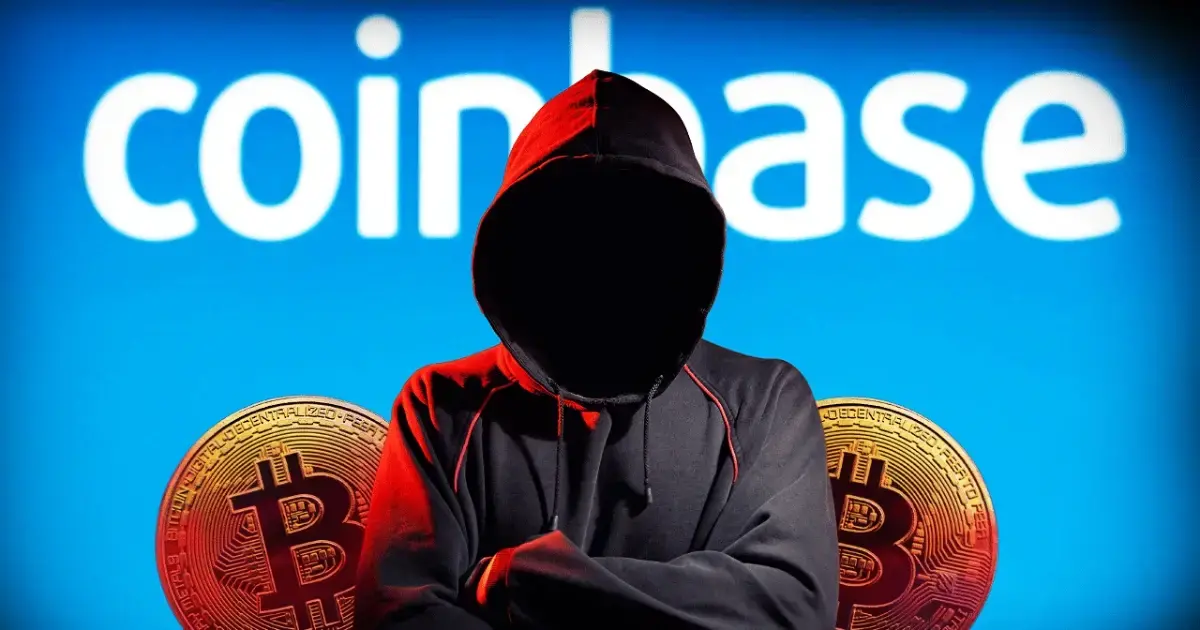B3D Research: The Key to Unlocking the Next Bull Market
Author: Brand3DAO
Contributors: Payne, Julie, Jennie
The sharp decline in 2022 has plunged the crypto market into another winter, and the slight rebound in the first month of 2023 has led people to start anticipating the arrival of a new bull market, trying to find answers: what is the key to unlocking the next bull market?
The starting point and catalyst of the 2020 bull market cycle: DeFi and NFTs created new wealth and new markets. Most of those who are proficient in using wallets and various on-chain products are seasoned blockchain users, and the lasting intrinsic motivation they bring is an important source of overall market growth. However, whether they are the key drivers behind new funds and new markets remains debatable.
Regardless, one thing is certain: the blockchain industry has reached a scale of $2 trillion, relying on new funds, new users, and new technologies, as well as the key channels that connect these increments; whether it's Robinhood allowing trading of digital assets, or Gray Scale launching futures ETFs, or even the further expansion of CEXs—they have all lowered the barriers for the general public to access and trade digital assets, gradually bringing non-mainstream assets into the mainstream view. Lowering barriers and facilitating more users to participate in Web3 is a prerequisite for expanding the market. CZ's recent comments in an AMA also confirm optimism and attention towards this direction: Binance will continue to invest to make DeFi more accessible and usable. The product team will also continue to simplify the KYC process.
No profit, no early riser; funds, users, and developers are flooding into the world of Web3 like a torrent. However, within the rich yet fragmented ecosystem of Web3, new funds face an explosion of information regarding various value narratives, new users struggle to adapt to complex and chaotic operational logic, and new developers find themselves in a resource-wasting cycle of reinventing the wheel.
In light of this situation, one can't help but wonder: if we could develop a unified operating system for Web3, similar to how the Android system changed the landscape of the mobile internet, it would flatten the barriers to Web3 and eliminate the walls between various ecosystems, creating the necessary conditions for a massive explosion of DApps within Web3.
In this article, we will review the revolutionary role of the Android system in the development of the mobile internet, detail and compare it with the current state of Web3, and explore how a unified Web3 operating system can unlock the next bull market.
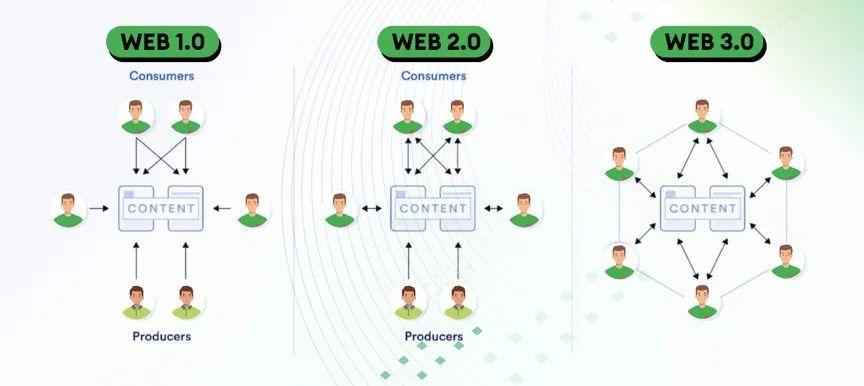
Current State of Web3 Applications: Connected Consensus, Disconnected Ecosystems
Divergence and Consensus Coexist, Closure and Connection Coexist
Layer 1 public chains rely on their different planning in TPS (speed), application diversity, security, and usage costs to carve out their own territories within the Web3 ecosystem, building various upper structures (DApps) based on different needs. The explosive growth of public chains has led to a seemingly prosperous yet chaotic scene—users who just experienced the "steam age" on one public chain need to re-enter the "stone age" when switching to another public chain.
The fragmented public chain ecosystem brings great inconvenience to both users and developers. For example, users need to perform complex operations to switch between ecosystems, while developers need to reinvent the wheel in project deployment and subsequent operations across different public chains. In summary, amidst the coexistence of prosperity and fragmentation in this blue ocean, pain points are surging, hiding opportunities.
The phrase "you must pay to earn" in Web3 has a different meaning than in traditional contexts. If you are using on-chain services for the first time, you need to obtain initial gas from a centralized exchange or a friend to pay for transaction fees on the chain; without these initial resources, you can only be a spectator, unable to perform any operations.
If you want to participate in liquidity mining or NFT trading, you need to transfer assets from initial chains like ETH to the chain required by the platform. For example, to provide liquidity for SpookySwap on Fantom, you need to go through: downloading a wallet plugin, remembering the mnemonic phrase, obtaining FTM as gas, acquiring USDC on ETH, authorizing the cross-chain bridge to use USDC, transferring USDC from ETH to Fantom, authorizing SpookySwap to use USDC on Fantom, making a trade, and authorizing SpookySwap to use LP. This process is cumbersome and complex, deterring most "troublesome" internet users.
Even for seasoned users, they may miss important trading opportunities due to the cumbersome process or face additional troubles from mistakenly selecting the wrong chain. There are many creative DApps, but due to the lack of a unified operating system, it is difficult to attract more users to join Web3.
Lessons from History: Web3 Does Not Need to Reinvent the Wheel
Problems of Early Mobile Internet
Let's take a time machine back to the early mobile internet. Back then, if you wanted to transfer photos between different brands of phones, you needed to download one software to upload the photos to your computer, then download another software to transfer the photos to another phone.
If you wanted to play the same game on different brands of phones, you had to log into different servers, but the equipment and progress you had previously charged could not be migrated. If you wanted to make a bank transfer or transaction, you had to queue at the bank or log in through online banking by inserting a USB shield for verification. Although the early mobile internet technology was irreplaceable at the time, various existing problems only attracted a small number of geeks and user leaders.
For developers, the issues brought by platform fragmentation and device differences were a nightmare. In early Web2 development, these problems mainly stemmed from adapting to different programming languages and screen sizes. Often, development teams would choose to abandon software adaptation for certain devices to avoid inefficient work caused by redundant development, or directly use software designed for other screen sizes and resolutions, completely disregarding user experience.
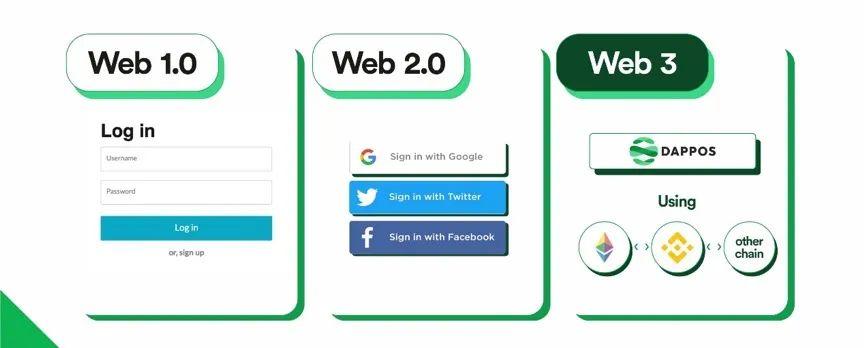
Comparison of Web3's Current State with Early Mobile Internet
In the early mobile internet era before the advent of the Android system, mobile phone manufacturers faced many similar difficulties to today's major public chains, as detailed in the table below:
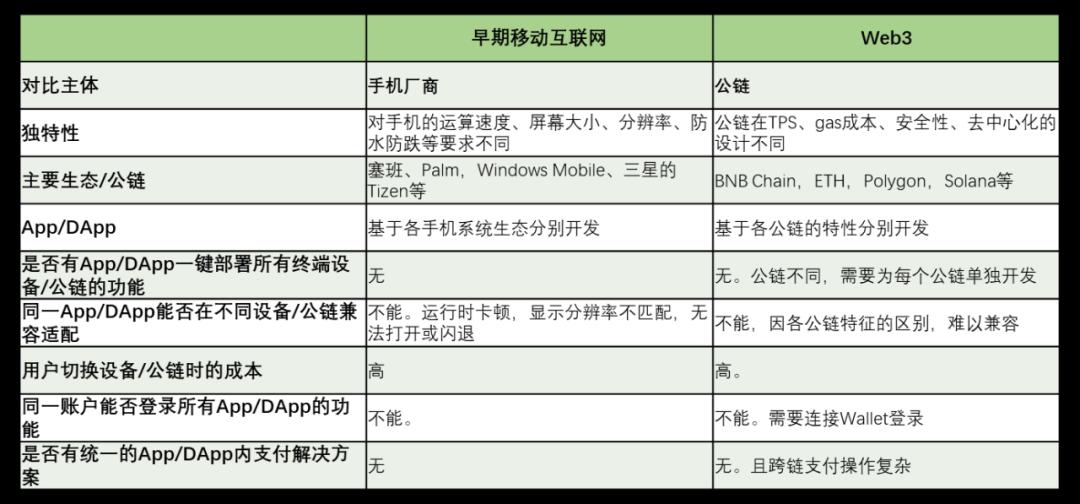
The problems faced by early mobile phone manufacturers have become even more severe in Web3. Not only is there no efficient multi-chain development and deployment of DApps at the technical level, but the flow of funds across chains is also greatly affected. "To get rich, first build the roads"; due to poor liquidity across different chains, deploying a project (DApp) on a new chain means starting from scratch to rebuild liquidity, and project parties need to spend high costs to operate the new chain to improve liquidity.
The best user experience is to minimize operations and experiences. However, in the Web3 ecosystem, users must interact with wallets during interactions, and when experiencing DApps from different ecosystems, they also need to manually switch in their wallets, increasing the difficulty of interaction. Therefore, this user experience has already been eliminated in Web2. Without a good operational experience, it is difficult to attract users, and it is also challenging to keep users patient enough to explore more content within DApps.
The current problems in Web3 not only severely affect user enthusiasm, discouraging on-chain interaction and consumption behaviors, but also increase the difficulty for developers to expand their businesses, indirectly limiting the quality of DApp projects, leading the entire industry to be constrained by liquidity issues and unable to develop fully. If these problems can be solved in the current bear market, the result will be akin to the birth of the Android system, breaking through the technical barriers and ecological walls of the past internet era, ushering in a new revolution in mobile internet development. Therefore, the next bull market will undoubtedly thrive on a brand new and broader foundation.
Seeking Common Perspectives and Views
In contemplating the future of Web3 and the crypto market, users, developers, and venture capitalists will analyze the value and market prospects of products from the perspectives of user experience, development difficulty, and market potential. Among them, Joey Krug, co-CIO of Pantera Capital, provided an objective summary of the existing problems in the entire market and a rough direction for solutions.
The first issue revolves around the user experience (UX) of wallets. Although MetaMask has done a lot for the market, it is a simple browser extension and not a powerful application with a well-designed user experience. Its layout is confusing, and novice users may feel overwhelmed, with the UI (user interface) being too complex. It reminds me of the old Palm or Windows handheld devices that existed before the iPhone. Perhaps a long-term solution would be a retail wallet based on MPC.
The second issue is that transaction fees must be paid in ETH. This means that in addition to sending/trading any assets, ETH is also required. The idea of economic abstraction solves this problem. By upgrading the Ethereum protocol locally, it would allow transaction fees to be paid with tokens other than ETH.
The third issue is about how to integrate increasingly better fiat gateways in decentralized applications (dApps). Currently, there is a lack of a solution that can be natively integrated into decentralized applications, similar to the mass-market integration of Stripe. In this way, dApps could add fiat gateways, allowing users to purchase cryptocurrencies with a simple click, and at a lower cost. However, such a solution does not currently exist; it needs to be embedded as a widget in the UI, and no one controls the UI (i.e., dApp). Currently, Stripe's new crypto gateway product does not address this issue.
Based on the current pain points, this article summarizes four characteristics that solutions should possess:
- Provide developers with a standard development and deployment environment, and offer users a unified and rich software ecosystem.
In the software field, there is a saying: "The beauty of simplicity" (worse is better). No one would refuse such a beautiful ecosystem: different types of businesses can operate normally within it, providing services to all users; users can enjoy the content and services they need without spending too much time and learning costs; users can freely use and trade their assets.
In the fierce competition of the mobile internet market, there is already an Android-based ecosystem serving Web2 users. Therefore, for Web3, if it can provide standardized and unified SDKs, allowing developers to efficiently develop and easily deploy development environments, while users can maintain the same usage habits across any device and platform and experience various content and services, such an ecosystem will undoubtedly become a playground for users in the Web3 world and a gathering place for developers and funds.
- Provide users with a unified account login experience, UI design, and seamless cross-chain experience for dApps.
"The best design is self-evident; it can explain itself." Simplifying the login methods and steps of applications can reduce the difficulty of use for users, and this low-threshold user experience reflects the quality of the product. Google accounts can be used for one-click login to Android applications, allowing users to experience the services provided by the applications, with their software settings and usage records saved in their Google accounts; even if they forget their passwords, they can reset them through authentication. This user experience is one of the reasons users continue to use Google services.
In Web3, users need to use mnemonic phrases to verify and log into wallets, and the mnemonic phrase also serves as the password for accessing the crypto wallet. Since users' data and assets are distributed across different chains, when users forget their passwords or perform cross-chain operations, the operational steps can become very complex, significantly impacting user retention. Therefore, ensuring that users do not feel a sense of disconnection in the UI when switching between dApp services and achieving unified login and account recovery functions through Google accounts is the user experience that Web3 needs.
- One interaction should automate multi-chain and multi-task operations for users.
In Web3, users need to perform multiple steps to complete tasks on a single chain or across multiple chains, leading to complex operations and poor user experience. For example, in liquidity mining, users need to go through five contract interactions (such as approving tokens A/B, adding liquidity, approving LP tokens, depositing, etc.) to achieve the goal of entering the pool.
To improve user experience, a payment technology needs to be developed that helps users simplify operations, including a clean UI and multi-task, multi-operation packaging processing capabilities behind it. This way, users only need to click once, and the dApp can help them complete all interactions, including gas payments, cross-chain transactions, approvals, and other complex repetitive interactions, thereby reducing the likelihood of users abandoning Web3 due to complex operations.
- DApps can have built-in unified and convenient payment technologies.
Whether in shopping or trading scenarios, people have become accustomed to the convenient payment functions within apps. When using Google Pay, users only need to confirm transaction information, enter the amount (sometimes automatically displayed), select the account where the funds are located, and confirm the transaction to complete the entire payment process.
In Web3, however, users need to adapt to the limited payment functions provided by different DApps, as the tokens supported by different DApps may not be the same, making it difficult for users to use existing tokens for payments or transactions. Therefore, Web3 needs a payment method similar to Google Pay, which can provide users with complete, convenient, and token-supported payment functions within DApps, making the user experience as convenient as traditional payment methods.
Feasible Solutions
In the ecosystem of a unified Web3 operating system, various projects are striving for an edge. The design of different ecosystems significantly affects the richness, user experience, and interoperability of DApps. A unified ecosystem plays a foundational and key role in Web3, which is why many major funds and leading centralized exchanges have begun to pay attention and provide support. It is foreseeable that competition for a unified ecosystem will become increasingly fierce. 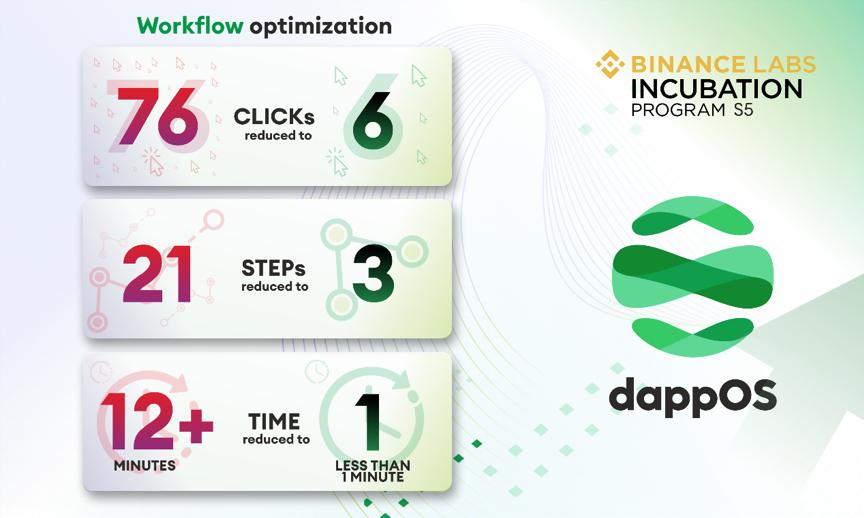
As a leading centralized exchange, Binance is also focusing on ecosystem construction. Among many ecological projects, Binance's Binance Lab has recognized dappOS as one of its potential projects, selecting it for the fifth season of its incubation program. This means providing the project with market opportunities, community support, and institutional guidance.
By comparison, it can be found that the unified SDK provided by dappOS is relatively comprehensive in terms of functionality, operation, speed, rates, and security, indicating its unique characteristics and advantages. Additionally, dappOS offers a Mini Program Platform, providing unified and convenient payment functions for DApps within the ecosystem and users using DApps. For example, features such as virtual wallet recovery, automatic handling of complex settlements by the system, and multi-assets serving as gas fees demonstrate its greater potential compared to competing projects.
Solutions for Achieving Technological Transformation in Web3
- DappOS Account
In dappOS, users use contract-based accounts, referred to as virtual wallets, instead of traditional externally owned accounts (EOA). Typically, if users forget the mnemonic phrase to log into their wallets, the assets in the wallet will be permanently unrecoverable. However, dappOS Account can be reset in such cases through various methods. Therefore, users can use and reset their virtual wallets in dappOS without a mnemonic phrase. With dappOS Account, users can log into dappOS as conveniently as logging into a Web2 app, eliminating the troubles brought by mnemonic phrases and aligning with the usual usage habits of apps.
Virtual wallets are scalable and can solve the problem of "using a wallet requires gas first." Virtual wallets can not only allow third parties to pay gas fees but also support other assets (such as tokens, assets in centralized exchanges, or even fiat currencies) to pay for gas fees, in addition to native tokens. Furthermore, when a user's balance is insufficient, the system can automatically pull equivalent assets from other chains after user confirmation for combined payment, similar to how Alipay supports balance + bank card payments. For the user's first interaction on each new chain, dappOS will automatically create a uniquely attributed virtual wallet for the user based on the different new chains, making it easier for users to find the correct wallet for future cross-chain operations and laying the groundwork for one-click automated execution of multi-task operations.
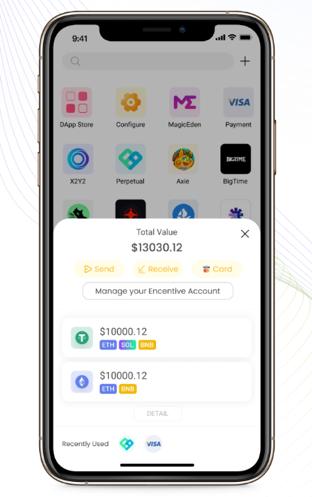
- dappOS Network
dappOS Network can provide users with automated operation execution services. This means that users only need to provide a signature confirmation, and dappOS Network will perform interaction operations for users across multiple chains using virtual wallets, including cross-chain payments, exchanges, and other multi-chain and multi-step tasks. What might originally take over 10 minutes of manual operation can be completed in less than 1 minute with the help of dappOS Network's "one-click confirmation."

The consensus mechanism of dappOS is achieved through nodes, with two types of nodes:
- Super nodes: Receive user delegated orders and assign them to server nodes, supervising completion and providing rewards and penalties;
- Service nodes: Responsible for receiving orders delegated by super nodes and executing them, earning certain token rewards upon completion.
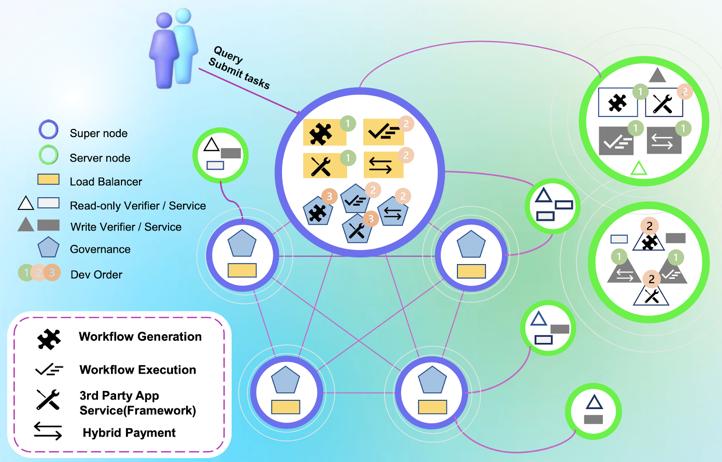

Through this consensus mechanism, service nodes and super nodes work together to ensure that cross-chain requests or multi-step operations submitted by users are completed smoothly. Among them, becoming a super node requires staking platform tokens, but executing delegated orders can earn platform token fees; service nodes can earn corresponding rewards from the fees for executing delegated orders.
- dappOS SDK
When developers deploy DApps across multiple chains, the DApp SDK provides a simplified solution to help users on chain A experience DApps on chain B without needing to redeploy contracts to attract liquidity. For example, a DApp deployed on the BNB Chain can easily attract users from DApps on the ETH chain without needing to guide users across chains, purchase gas, or set up wallets. Developers deploying DApps across multiple chains can effectively connect users across different chains, replicating their advantages on chain A to chain B, saving time and effort for new chain operations.
For developers, dappOS makes one-click deployment across multiple chains possible by providing SDK integration. Additionally, the Mini Program Platform is about to launch, allowing users to experience a user experience similar to Web2 on DApps, maintaining their usual usage habits and user experience.
- dappOS provides DApps with one-click, automated payment methods.
Users accustomed to paying orders and bills through apps should be very familiar with the built-in payment functions of apps, and dappOS also aims to provide a similar experience for DApp users. From supporting gas payments, cross-chain interactions, to contract approvals, users only need to confirm payment information (mainly the payment amount), click once to confirm, and dappOS will automatically complete all operations. Aside from public chain transactions requiring a waiting period for confirmation, other aspects are basically the same as the payment experience in Web2 applications.
DeFi, as the foundation of the next cryptocurrency cycle, has also become one of the first adopters of dappOS due to its inherently complex operations. DeFi platforms, including Perpetual, Benqi, and QuickSwap, have successively integrated dappOS as a tool for users to swap tokens, enhancing user experience. In the past, users needed to spend 30 minutes swapping tokens before entering the platform for trading or participating in liquidity mining, but based on the automation advantages of dappOS, this can now be achieved with just one click and a few minutes of confirmation time, resulting in what previously took 30 minutes of manual operation.
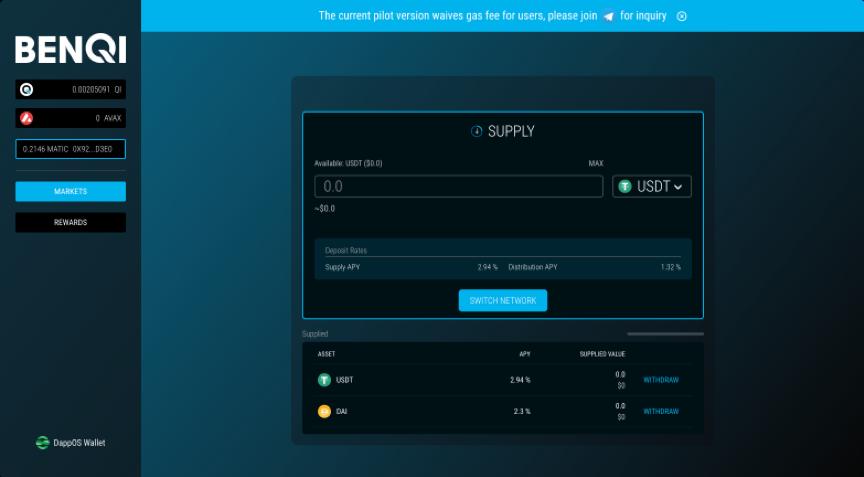
Recently, the Farming Activity conducted by dappOS in collaboration with QuickSwap has sparked user discussions on this "new payment model" on Twitter.


The leading DeFi protocol GMX has also reached a deep cooperation with dappOS, and the preview version of the GMX platform integrated with dappOS SDK has officially launched, allowing users to seamlessly use GMX functions directly from their BSC wallets. Users can enjoy a consistently smooth operational experience while interacting with leading dApp ecosystems. According to dappOS's development roadmap, in February, it will also launch support for ETH users to simultaneously use the GMX platform on Avalanche and Arbitrum chains, implementing smart recommendations based on rates and liquidity. To encourage users to experience multi-chain integration technology, dappOS will collaborate with GMX to distribute interaction airdrops to the first batch of experience users.
Product link: https://gmx.dappos.finance/trade
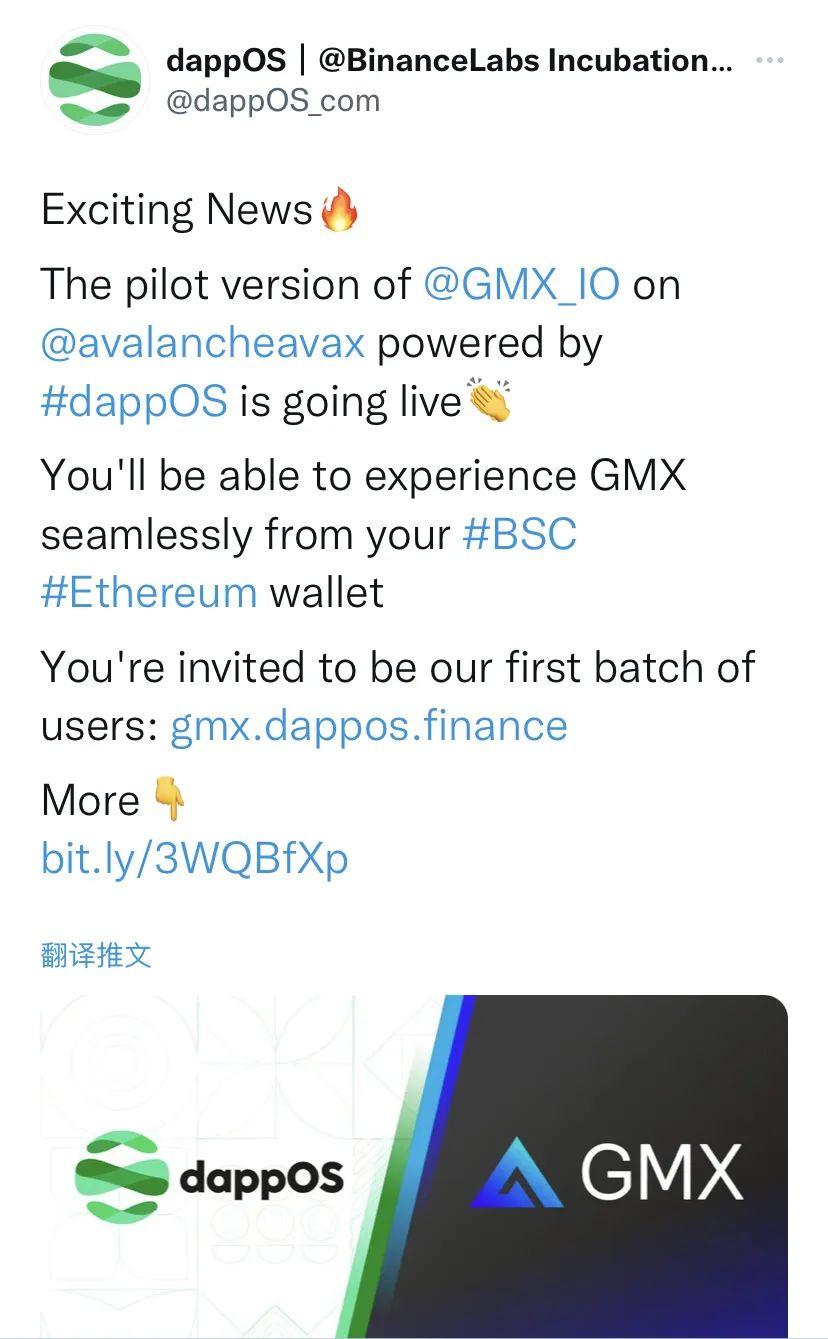

Can dappOS Become the Android System of Web3?
The Android system played a key role in the development of the mobile internet. In Web3, the Android system means that DApps can run on a unified operating system and infrastructure of Web3. By comparing the solutions to ecological issues between the Android system and dappOS, it can be found that dappOS's technical solutions for enhancing user experience, supporting developers, and building unified payments within DApps are very similar to the functions of the Android system in Web2.

Therefore, dappOS can achieve more and better support for Web3 users and developers through unified and standardized technical solutions. From DApp development and deployment to user experience, from free integration to simplified operations, from cross-chain payments to multi-task packaging processing, dappOS aims to create a new environment in Web3 that attracts users, developers, and potential investors.
Conclusion
In the early days of the mobile internet, mobile phone manufacturers fought their own battles without considering the impact of ecological issues on users and developers. The emergence of the Android system provided a unified ecological environment for app developers, allowing users to enjoy a wealth of services and content; later, it also provided a unified payment function, achieving a positive feedback loop between users, developers, and Android, enabling the healthy development of the Android ecosystem.
dappOS aims to become the first Android in Web3. It provides a unified ecological environment, allowing DApp content and services to take root through the provision of SDKs and standardized protocols. It also offers a simple and friendly UI and one-click execution of multi-task packaging operations based on single or multiple chains, ensuring user operation safety while enhancing user experience. By collaborating with various DApps, dappOS also provides payment functions, increasing the demand for cross-chain payments within Web3, attracting more users and funds into Web3, and bringing tremendous potential and momentum for the future development of the DApps ecosystem.
The positive feedback loop between "users-developers-dappOS" provides the necessary conditions for creating an "Android system" in the Web3 world, which will sound the horn for explosive growth of DApps when the next bull market arrives.






